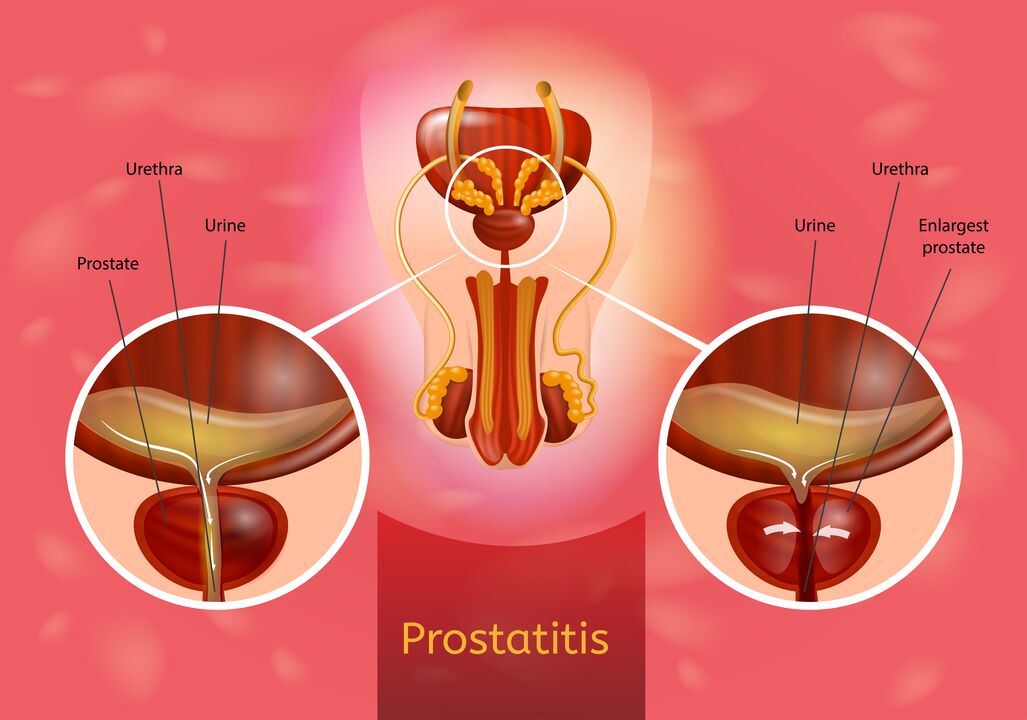The prostatitis is a prostate gland (prostate) that develops as a result of inflammatory changes.According to statistics, the spread of the disease reaches 35-50% and was found in men of 20-40 years.

Type
4 The form of prostatitis is different:
- acute (bacterial);
- chronic bacterial;
- chronic non-tborsial;
- Asymptomatic chronic.
The sharp prostatitis is very rare due to the rapid progress of the inflammatory process and the immediate passage of the chronic stage.
The chronic non-toastatite is called chronic pelvic pain syndrome, and not inflammation in the nature of inflammation.
Reasons
The cause of acute and chronic bacterial prostatitis pathogenic microorganisms (viruses, bacteria, mushrooms).The most inflammatory source:
- E. coli;
- Streptococci;
- staphylococci;
- Proteus;
- Klebsiella;
- Pseudomonal stick;
- Pathogens of sexually transmitted diseases (chlamidia, micoplasmas, Gonococci, Trichomonas, Sitomegalovirus and others).
Most microorganisms are caused by an inflammatory process to enter the guts, skin, but prostate texture.As a rule, the cause of the disease is not a pathogen, a few types of microbes.
The development of chronic prostatitis can provoke the following factors:
- inconsistent diseases of the urine system (cystitis, pyelonephritis);
- sedentary lifestyle ("sedentary" work);
- tendency to constipate;
- weakening of body protection;
- Injuries;
- hormonal imbalance;
- to exploit and smoke alcohol;
- casual sexual intercourse;
- Irregular sex life (for a long period of time);
- in sexual intercourse;
- irregular discharge of the sac;
- unsatisfactory sexual desire;
- chronic stresses;
- hypothermia;
- The presence of other sources of casious teeth and chronic infections (eg chronic tonzillit).
Prostatite symptoms
A sharp prostatitis is a very insidious disease.Initially, this makes the process very quickly, and the second, most patients prefer the manifestations of the acute prostatitis of the house.Patients with inflammation of the prostate often consult a doctor in developed cases and other results.
The sharp form of the disease continues in the background:
- fever;
- vibrations;
- Signs of other intoxication (weakness, lethargy, appetite, etc.).
The prostate gland is accompanied by pain in the inflammation of the perineum, in the inguinal region and the scrotum.
Painful and fast urine is also characteristic.Sometimes you can feel whitening cotton discharge in urine.
In addition, the patient may focus on the absence of night and morning erections, a poor abbreviation of a poor structure and sexual intercourse during the proximity.
Typical symptoms of urinary disorders appear: Although the urine itself is slightly different, urine and frequent call flow.
In the absence of treatment in the future, the chronic prostatitis reaches the apogey: the disorders of sexual function appear.For example:
- inadequate erection or absence;
- Painful erections, because the patient fled from sex;
- Deleted orgasm;
- Short contact;
- The pain of discharge.
The chronic abacterial prostatitis is 95% among all prostatitis, mainly from men in the age of 30.It is characterized by constant or periodic pain in the prostate, the scrotum, and there are no signs of inflammatory analysis in laboratory analysis.The reasons for the disease are not necessarily established.
Diagnosis
In addition to the diagnosis of acute and chronic prostatitis, complaints, Anamnez and patient examination, the following methods are used:
- General blood and urine test;
- Sown to a food environment for the microscopic examination and pathogenic examination of the prostate (mystery after being taken after the finger massage from the cake);
- Urinary citational study;
- Ultrasound of prostate and pelvic bodies;
- Calculated tomography and nuclear magnetic resonance (MRI);
- A mess from the urethra in microflora.
Differential diagnosis is directed to differentiate between prostatitis, prostate adenoma, prostate cancer, the signs of the stone in the prostate gland.
A complete list of diagnostic procedures and drugs for the treatment of prostatitis in the federal assistance standard.
Treatment of prostatitis
The same symptoms may have signs of various diseases and the disease cannot occur according to textbooks.Don't try to treat yourself - go to the doctor.A surgeon-urologist causes prostatitis.
The purpose of the pathogenic treatment is to remove pathogenic treatment aimed at eliminating the cause of prostatitis.Depending on the specified cause, antibiotics are assigned to antiviral or antifungal medications.The term of therapy for acute prostatitis is 7-10 days, in chronic process-4-8 weeks.
They are used to treat a bacterial infection:
- antibiotics (ciprofloxacin, levofloxacin, moxiethloxasin);
- macrolids (erythromycin, clarithromycin);
- Doxycycline;
- Antibacterial drugs.
AntiFungal (Diflucan, Fluconazole) is determined by oral and rectal candles.
In addition, other types of therapy are used:
- anti-anti-anti-opposite (suprastin, claritin, dimedrol);
- anti-inflammation (indometacin, diclofenac);
- Anesthetics (No-SHPA, Analgin, Baralgin).
They are also appointed:
- Physiotherapy;
- Medical gymnastics;
- Prostate massage.
The whole course of treatment takes 3-4 months.
Prevention
The following conditions must be observed to prevent the disease:
- Permanent sex life;
- rejection of bad habits;
- Keep a healthy lifestyle (play sports, walk in a fresh air);
- Conformity with a diet;
- Regular visit to the urologist.























